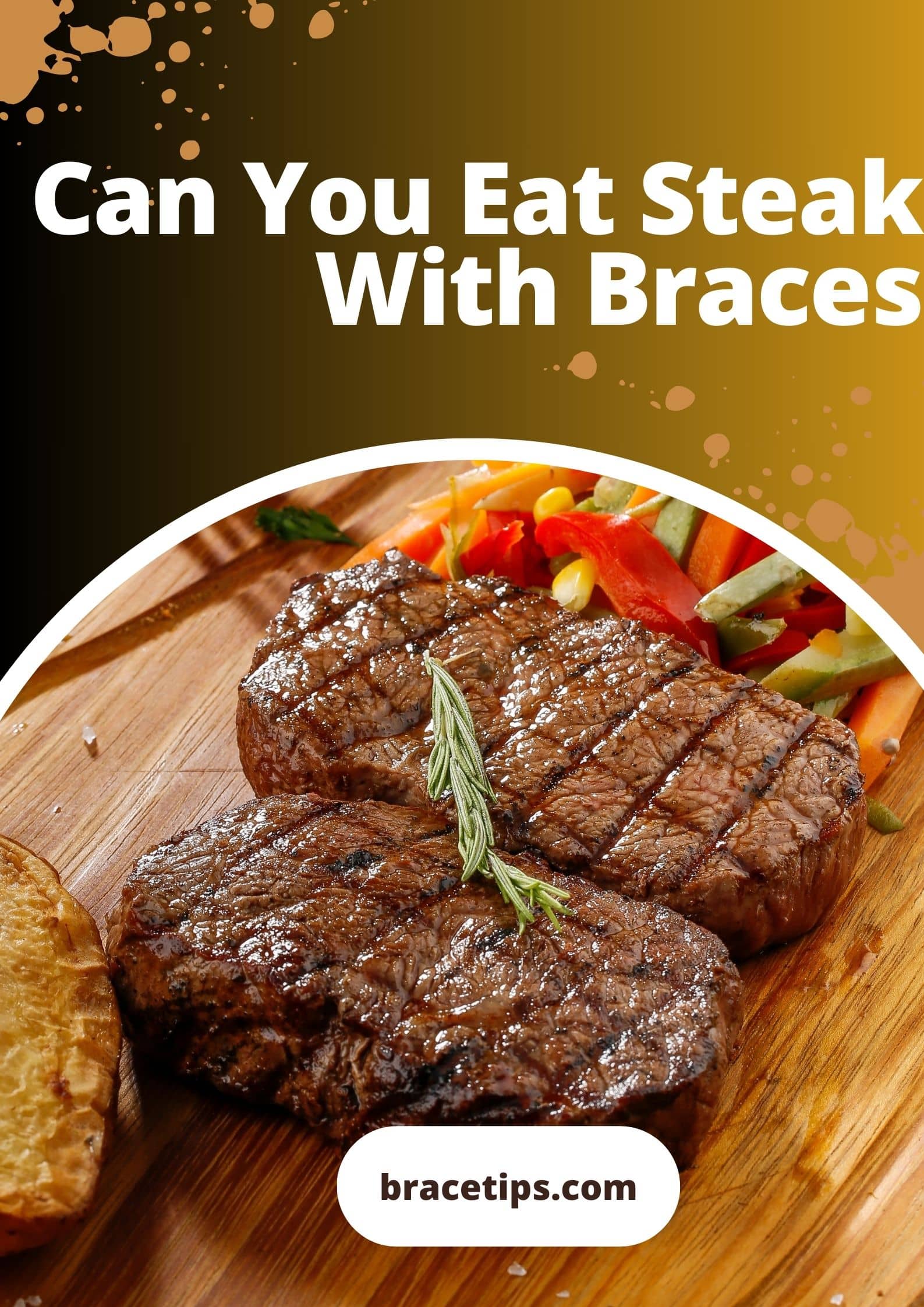Can You Eat Steak With Braces
Getting braces can be a daunting experience, especially when it comes to dietary restrictions. Among the various food options, steak—a beloved and nutritious choice—raises many questions for those with braces. Can you indulge in steak immediately after getting braces? What cuts are safe, and how should you navigate eating this delicious meal without causing harm? One such dilemma often arises with steak consumption. Can you eat steak with braces it is not impact braces. The prospect of indulging in a juicy, flavorful steak may seem daunting for individuals with braces due to concerns about potential damage. In this comprehensive guide, we’ll explore whether eating steak with braces is feasible, the importance of adhering to dietary restrictions, suitable cuts of steak, strategies for safely enjoying steak with braces, and additional tips for a smooth dining experience.
Understanding Braces and Diet
Before delving into the specifics of consuming steak with braces, it’s crucial to understand why certain foods pose challenges during orthodontic treatment. Braces, comprising brackets, wires, and bands, work towards repositioning teeth. As such, they are sensitive to hard, sticky, or chewy foods that could potentially damage or dislodge the brackets and wires. However, they come with dietary restrictions that often raise questions about what foods are safe to eat. Among the queries, one frequently asked is whether steak, a beloved and often-craved dish, can be enjoyed while wearing braces. Let’s dive into the nuances of enjoying steak with braces and explore the dos and don’ts for a comfortable and hassle-free dining experience.
Can I Eat Steak Immediately After Getting Braces?
The importance of adhering to dietary restrictions post-braces installation cannot be overstated. Initially, indulging in tough or chewy foods like steak right after getting braces can pose significant risks. The brackets, wires, and overall adjustment in the mouth require a transition period. Consuming steak immediately may lead to discomfort, potential damage to braces, and extended soreness. During this time, it’s advisable to stick to softer foods that don’t require intense chewing to avoid discomfort or damage to the braces. Consuming steak immediately after getting braces is not recommended. It’s essential to allow your mouth to adapt to the braces and for any initial soreness to subside before attempting to eat tougher foods like steak.
Importance of Following Dietary Restrictions
Following dietary guidelines provided by your orthodontist ensures the successful and timely completion of your orthodontic treatment. Dietary restrictions prevent damage to braces, minimize discomfort, and aid in the effectiveness of the treatment. Adherence to these restrictions facilitates a smoother journey toward achieving a straight and healthy smile. Certain foods can pose a risk to the braces themselves, causing damage or dislodgement. Hard, chewy, or sticky foods, including some cuts of steak, fall into the category of items to avoid. These foods can potentially bend wires, displace brackets, or get stuck between teeth and braces, leading to discomfort or even emergencies requiring immediate attention from an orthodontist.
What Cuts of Steak Should You Avoid Eating With Braces?
When considering steak cuts, certain types are friendlier to consume with braces than others. Avoiding tough or overly chewy cuts is advisable. Cuts such as porterhouse, T-bone, and some sirloin varieties tend to be tougher and may pose challenges when consuming with braces. Opting for softer cuts like tenderloin or filet mignon can make the eating experience more manageable. Some cuts are tougher and require more forceful chewing, which can be problematic for braces wearers. Cuts like T-bone, porterhouse, and certain sirloin steaks tend to be tougher and are best avoided. Opt instead for softer cuts like tenderloin or filet mignon that are easier to chew and less likely to cause issues with braces.
How To Eat Steak With Braces
Preparing Your Steak for Braces
Before indulging in steak, it’s prudent to prepare it in a manner that makes it easier to chew and consume. Cutting the steak into smaller, bite-sized pieces can reduce the strain on your braces and make chewing more manageable. Cutting the steak into smaller, bite-sized pieces can significantly reduce the effort required for chewing. Slicing the meat against the grain can also make it more tender and easier to chew, aiding in a smoother eating experience.
Tips for Eating Steak with Braces
- Chew Mindfully: Take smaller bites and chew slowly to reduce the stress on your braces.
- Avoid Tough Portions: Trim any gristle or tough parts before eating.
- Use the Back Teeth: Directly biting into the steak with your front teeth may exert unnecessary pressure on your braces; utilize your back teeth for chewing.
- Rinse After Eating: Swishing water in your mouth post-meal can help dislodge any food particles stuck in your braces.
- Take Small Bites: Consuming smaller bites of steak reduces the stress on your braces while chewing, minimizing the risk of damaging them.
Can I Eat Steak with Braces if I Have Rubber Bands?
If you have rubber bands along with your braces, exercising caution while consuming steak becomes even more crucial. Rubber bands add an additional level of complexity, and it’s advisable to consult your orthodontist regarding specific dietary recommendations to ensure the rubber bands’ effectiveness and your comfort. However, it is still possible to enjoy steak with caution. The key is to follow the tips mentioned earlier, take smaller bites, and be extra diligent while chewing to prevent any damage to the braces or rubber bands.
Can You Eat Steak With Braces?
The Texture of Steak: A Consideration
Steak, known for its tenderness and flavor, often varies in texture based on the cut and preparation. While some cuts are more tender and easier to chew, others might be tougher and require more effort. Understanding the texture of the steak is pivotal in determining its compatibility with braces.
Tender Cuts: The Ideal Choice
Certain cuts, like tenderloin or ribeye, boast tenderness, making them more suitable for consumption with braces. These cuts are usually softer and less resistant to chewing, reducing the risk of causing damage to braces components.
Tougher Cuts: Caution Advised
Conversely, tougher cuts, such as sirloin or flank steak, might pose challenges. These cuts tend to be chewier and can exert more pressure on the braces, potentially leading to discomfort or even damage.
Preparing Steak for Braces
Cutting Techniques: Ease of Consumption
Cutting steak into smaller, bite-sized pieces can significantly aid in easing the chewing process. By reducing the size of each piece, less strain is put on the braces while enjoying this delectable meal.
Cooking Methods: Tenderizing the Steak
Opting for cooking methods that tenderize the meat, such as marinating or slow cooking, can further enhance the tenderness of the steak. Tenderized steak is gentler on the braces, minimizing the risk of causing any issues.
Best Practices for Enjoying Steak With Braces
Chew Mindfully: Take Your Time
When consuming steak with braces, adopting a mindful chewing approach is paramount. Taking smaller bites and thoroughly chewing the food before swallowing can prevent unnecessary strain on the braces.
Maintain Oral Hygiene: Post-Meal Care
After indulging in a steak meal, thorough oral hygiene practices become crucial. Cleaning the teeth, braces, and gums meticulously helps remove any food particles that might have lodged in the braces, preventing potential complications.
FAQ Section
Q: Can I eat any type of steak with braces?
A: While some cuts are easier to chew and safer for braces, it’s advisable to avoid extremely tough cuts that may cause discomfort or potential damage to the braces.
Q: Are there specific ways to cut steak for easier consumption with braces?
A: Yes, cutting the steak into smaller, manageable pieces can significantly reduce the strain on braces while eating.
Q: Should I avoid steak altogether while wearing braces?
A: Not necessarily. Opting for tender cuts, cutting them into smaller pieces, and practicing mindful chewing can make consuming steak a feasible option during orthodontic treatment.
Q: How should I care for my braces after eating steak?
A: Thoroughly clean your teeth, braces, and gums after enjoying steak to ensure no food particles are left behind, potentially causing issues.
Q: Can I eat steak immediately after getting braces?
A: It’s advisable to avoid steak and other tough foods immediately after getting braces to allow your mouth time to adjust.
Q: What cuts of steak should I avoid eating with braces?
A: Cuts like T-bone, porterhouse, and tougher sirloin steaks should be avoided due to their difficulty in chewing.
Q: How can I make eating steak easier with braces?
A: Prepare your steak by cutting it into smaller, more manageable pieces and chew slowly and cautiously.
Q: Can I eat steak with braces if I have rubber bands?
A: Yes, but it’s essential to be extra careful when chewing to prevent damage to the braces or rubber bands.
Conclusion
Enjoying steak with braces requires mindfulness and preparation. Understanding the importance of adhering to dietary restrictions, choosing appropriate cuts, and adopting eating techniques tailored to brace wearers can make indulging in steak a more pleasant experience. Whether you’re a steak enthusiast or just craving a juicy piece, navigating the world of steak with braces is indeed possible with the right knowledge and approach. Preparing it appropriately, and employing mindful eating habits. Adhering to dietary restrictions and being cautious while consuming tougher foods can help prevent damage to your braces, ensuring a smoother orthodontic journey without sacrificing your love for steak. By choosing tender cuts, cutting them into smaller pieces, and chewing mindfully, individuals undergoing orthodontic treatment can relish this favorite dish without compromising their braces’ integrity. As always, it’s recommended to consult your orthodontist for personalized dietary advice during the braces-wearing period.

